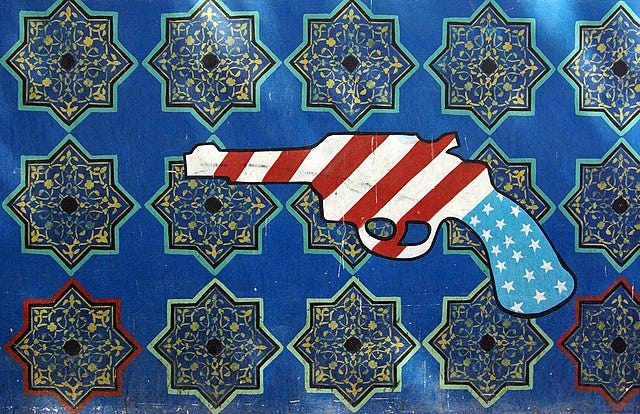How Iran Is Winning
Israeli strikes have hammered Iranian infrastructure, military sites, and nuclear facilities — but how much have they really achieved?

Earlier this month, I attended a research event at Chatham House, it focused on the breakdown of global diplomacy and the changing nature of power. It came just days before Israel’s first wave of attacks on Iranian territory. One of the standout papers, The Shape‑shifting Axis of Resistance by Renad Mansour, Haid Haid, and Hayder al‑Shakeri, explored how Iran and its regional partners have evolved into a flexible, decentralised network that thrives in chaos. The report underscored a growing reality: Iran is not just surviving. It is adapting, and in key ways, it is still winning.
A War Machine Built to Survive
Iran’s strength is drawn not from traditional armies or formal alliances, but from a system of allies that straddle the line between state and non-state. Hezbollah in Lebanon, the Houthis in Yemen, the Popular Mobilisation Forces in Iraq, and the fractured remnants of Hamas in Gaza together form the Axis of Resistance.
What makes these groups formidable is their dual function: they provide both military resistance and basic governance. From security and welfare to fuel distribution and judicial enforcement, these actors fill vacuums where central governments have collapsed or withdrawn. Iran's role is not just to arm them, it is also assisting them to embed in transnational networks that can survive shocks and reconfigure strategically when needed.
Years of war, sanctions, and austerity have hollowed out the middle class across the Middle East. In its place, armed groups offer stability, salaries, and social services. Hezbollah runs medical clinics in Lebanon. The PMF distributes aid and provides employment in Iraq. The Houthis administer everything from courts to food rations in Yemen. As state legitimacy erodes, paramilitary legitimacy grows. Iran has been able to use this to its advantage.
When Assad’s regime weakened in Syria, Iran was able to reinforce Hezbollah's drug-based economy, and redirect investment to Iraq and Yemen. This has allowed its allied ideological movements to embed in the political-economic ecosystems that now outlast the regimes they once propped up.
Captagon, the amphetamine that flourished under Assad during the Syrian civil war, is a key example of the Axis’s ability to fuse legal and illegal sources of income. It now funds militias and security operations well beyond Syria. These networks of income are mulit-layered. Construction firms mask arms shipments, while fuel smuggling is used to fund hospitals. The result is a financial ecosystem that is adaptable and difficult to disrupt.
Economic Networks That Defy Control
Financial resilience is the Axis’s core strength. In Iraq, PMF factions receive state funding, receiving over $3.5 billion in 2024 alone. In Lebanon, Hezbollah operates both legitimate businesses and a vast shadow economy, despite recent Israeli attempts to break it.
Despite public alignment with Western sanctions regimes, Gulf financial centres quietly enable Iran. Cities like Dubai, Beirut, and London serve as hubs for shell companies, currency exchangers, and shadow logistics networks. As the Chatham House paper notes, many of the financial systems that sustain Axis-linked actors “run through global financial centres… via front companies and offshore accounts” that appear indistinguishable from legitimate trade.
This is the strategic paradox: the same states calling for Iran’s isolation are also, indirectly, facilitating the survival of its networks.
Iran’s ability to disrupt maritime trade is also among its most powerful assets. According to Windward, GPS jamming in the Strait of Hormuz and Arabian Gulf now affects nearly 1,000 ships a day. These disruptions allow Iran to disrupt global trade without risking a more direct conflict. It’s hybrid warfare executed through shipping lanes.
The threat of closure gives Tehran some leverage. So long as tankers must sail with caution, Iran retains a seat at the table—even without direct confrontation.
Israel’s Campaign Is Undermining Diplomacy
Airstrikes and military escalation may serve domestic political purposes in Israel or the U.S., but they are doing little to halt Iran’s nuclear ambitions. As Jane’s reported, Israeli strikes have inflicted physical damage but achieved no lasting strategic shift.
Meanwhile, Iran’s parliament has approved a draft plan to suspend cooperation with the IAEA—another blow to international monitoring.
This week, President Donald Trump announced a “complete and total” ceasefire between Iran and Israel, reportedly brokered with Qatari support. But this deal almost immediately collapsed with both sides launching fresh strikes. The led a frustrated Trump to tell reporters that both sides “have been fighting so long and so hard that they don't know what the fuck they're doing".
The current overall toll stands at close to 1,000 Iranians killed, with over 3,000 wounded. On the Israeli side, 28 people have been killed by Iranian retaliatory strikes, and more than 1,000 injured—according to AP and BBC reports. With the current ceasefire crumbling, what was framed as a diplomatic breakthrough is unravelling into strategic irrelevance.
Trump, a self-styled master of “the art of the deal,” may have helped broker this latest truce—but his own strikes and destabilising rhetoric are precisely what pushed Iran further from diplomacy and deeper into defiance.
Conflict Everywhere, Control Nowhere
This isn’t an isolated regional crisis—it’s symptomatic of a broader breakdown in the global order. According to the Uppsala Conflict Data Program, 2024 saw more armed conflicts than any year since World War II. The tools of the unipolar post-Cold War world; sanctions, strikes, and state-building, no longer hold. What replaces them is harder to define, but the Iranian regime has adapted to it faster than most.
Contrary to some predictions, Iran is unlikely to escalate dramatically. Its economic networks rely on financial flows through Dubai, Doha, and London. Wrecking those connections would undercut the very system that keeps the Axis afloat. In this war, restraint is strategy.
The West keeps playing by 20th-century rules: strike the regime, force collapse, install order. But Iran’s web of militias, bureaucrats, smugglers, and financial brokers can bounce back. Bombing nuclear sites won’t unravel that.



"former President Donald Trump" - oh, if only!